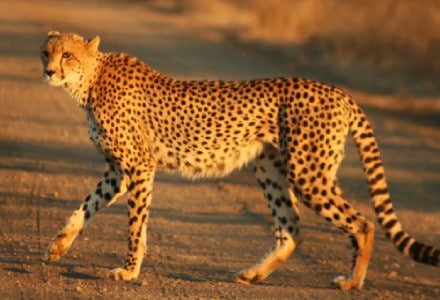
Cheetah Facts
- The Cheetah represents a large species of wild feline inhabiting most of Africa and portions of the Middle East. It remains the only surviving members of the genus Acinonyx.
- The mesmerizing animal also ranks as the fastest of all known land animals. It remains capable of attaining speeds of as much as 75 mph (120 kph).
- However, this speed is only in short bursts covering distances up to 1,600 ft (500 m).
- This magnificent animal also has the ability to accelerate from a standstill to 60 mph (96 kph) in as little as 3 seconds. The Cheetah is believed to have evolved in Africa during the Miocene Epoch (26-7.5 million years ago).
- Evidence indicates that it then migrated to Asia. Recent research places the last common ancestor of all existing populations in Asia 11 million years ago.
- Currently, at least six known sub-species exist.
Related Articles
Florida Panther Cougar Amur Leopard
Cheetah Physical Description
The Cheetah possesses a rather narrow waist and deep chest. The fur also grows short and coarse. The animal is primarily tan in color, with round black spots.
These spots typically measure approximately 0.8-1.2 in. (2-3 cm) in diameter. No noticeable sexual dimorphism is present in the species.
This color pattern provides natural camouflage. The underside is white, with no spots, and the tail has spots which merge to form four to six dark rings at the end.
The Cheetah has a small head, with high-set eyes. Their thin and fragile body makes them well suited to short bursts of high speed. However, they are not suited for endurance, yet they remain extremely agile creatures.
An adult may weigh as much as 159 lbs (72 kg), while the body length of the Cheetah averages about 59 in (150 cm). The tail averages roughly 24-33 in (60-84 cm) in length.
- Kingdom: Animalia
- Phylum: Chordata
- Class: Mammalia
- Order: Carnivora
- Family: Felidae
- Genus: Acinonyx
- Species: A. jubatus
Cheetah Distribution, Habitat, and Ecology
Currently, several populations of Cheetah exist, isolated geographically. All of these occur in either Africa or southwestern Asia. Additionally, a small population still survives in the Khorasan Province of Iran.
There, conservation efforts are underway to protect the survivors. There have also been unconfirmed reports of sightings in both India and Pakistan.
The Cheetah prefers large stretches of land, with abundant prey. It typically thrives in savannas, grasslands, and mountainous regions.
Males tend to form groups, often for life, yet the females are generally more solitary. The two sexes rarely intermingle, except for mating purposes. Except for the time spent rearing the young, the females live alone.
The stunning mammal also forms one of only four species of cat with semi-retractable claws. Interestingly, the Cheetah remains capable of purring, but not roaring.
Species Sharing Its Range
Indian Bullfrog Boomslang Jewel Wasp
Check out our other articles on Snow Leopard, Margay, 7 Truly Breathtaking Mammals, Marbled Cat

